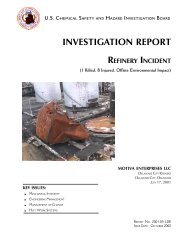CTA Report, Draft 1, ISP Review - US Chemical Safety and Hazard ...
CTA Report, Draft 1, ISP Review - US Chemical Safety and Hazard ...
CTA Report, Draft 1, ISP Review - US Chemical Safety and Hazard ...
You also want an ePaper? Increase the reach of your titles
YUMPU automatically turns print PDFs into web optimized ePapers that Google loves.
determine if those products are hazardous. This includes the identification <strong>and</strong> consideration of scientific<br />
evidence concerning their chemicals.<br />
The natural <strong>and</strong> black phenolic resins 19 <strong>CTA</strong> used are thermosetting resins. 20 The resin is ground by<br />
Borden <strong>Chemical</strong> to meet <strong>CTA</strong> specifications—in this case, 270 mesh, which produces particles ranging<br />
in size from 10 to 55 microns. Particles of phenolic resin of this size are combustible.<br />
In the early 1960s, the U.S. Bureau of Mines examined the explosibility of dusts used in the plastic<br />
industry. It determined that the explosibility of different types of formaldehyde resins—melamine, urea<br />
formaldehyde, <strong>and</strong> phenol formaldehyde—appears to increase as the nitrogen content of the primary<br />
ingredient decreases (Jacobson, Nagy, <strong>and</strong> Cooper, 1962). Phenol-formaldehyde resins contain no<br />
nitrogen <strong>and</strong>, thus, have the greatest explosibility for this class of resin.<br />
The Bureau of Mines test data on the explosibility of plastic dusts are referenced in many st<strong>and</strong>ard safety<br />
<strong>and</strong> health textbooks, including Patty’s Industrial Hygiene <strong>and</strong> Toxicology (Clayton, 1978), the Fire<br />
Protection H<strong>and</strong>book (NFPA, 1983), <strong>and</strong> the NFPA Inspection Manual (NFPA, 1994). Other st<strong>and</strong>ard<br />
safety textbooks, such as the Accident Prevention Manual for Industrial Operations (National <strong>Safety</strong><br />
Council [NSC], 1974), also list the explosive properties of phenolic resin dusts.<br />
8.2 Communication of Phenolic Resin <strong>Hazard</strong>s to <strong>CTA</strong><br />
This section describes Borden <strong>Chemical</strong>’s efforts to communicate to <strong>CTA</strong> the fire <strong>and</strong> explosion hazards<br />
associated with phenolic resins. The OSHA HazCom St<strong>and</strong>ard requires that chemical manufacturers<br />
describe the physical hazards of a chemical on an MSDS, including the potential for fire, explosion, <strong>and</strong><br />
reactivity, under normal use <strong>and</strong> in a foreseeable emergency. OSHA defines a foreseeable emergency<br />
19 A resin is a synthetic polymer or a natural substance of high molecular weight, which becomes moldable under<br />
heat, pressure, or chemical treatment.<br />
20 A thermosetting resin becomes soft <strong>and</strong> infusible or insoluble when heated; however, if heat is continually<br />
applied, the material fuses <strong>and</strong> becomes hard as the resin undergoes a chemical change during the curing process.<br />
61









